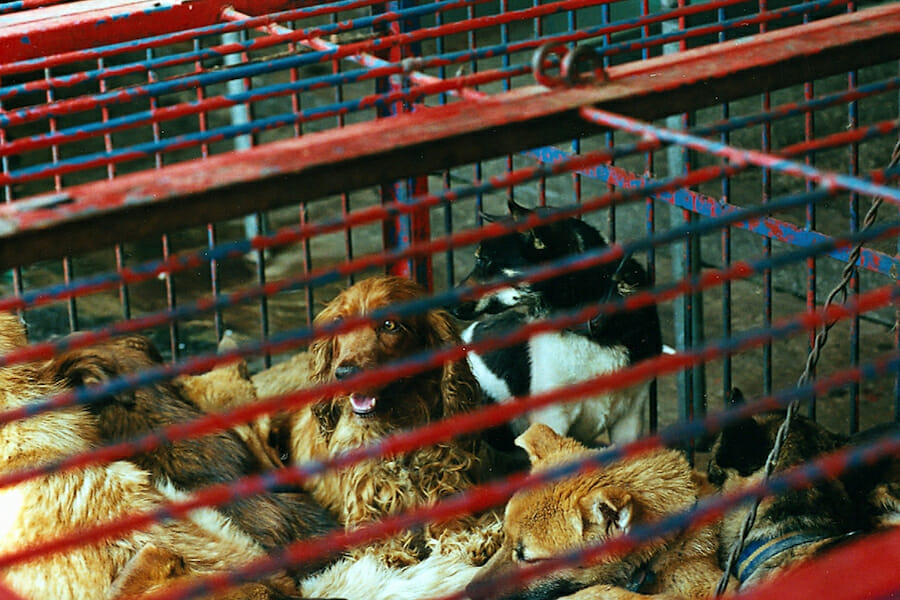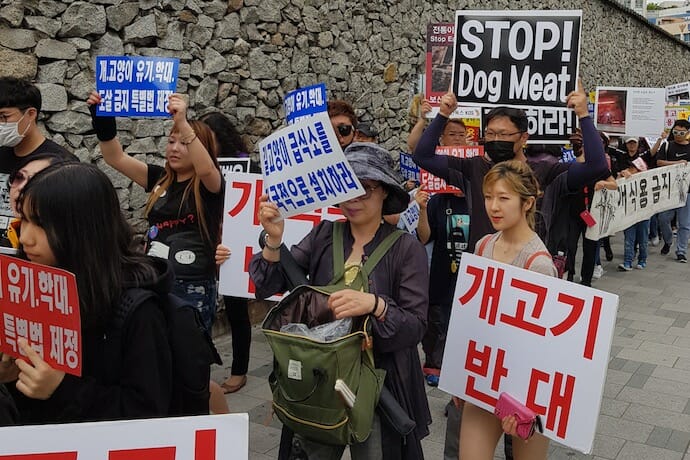
Food or Friend: The Day of Reckoning May Be at Hand for Korea’s Dog Meat Industry
Mahatma Gandhi once said that “[t]he greatness of a nation and its moral progress can be judged by the way its animals are treated.” Despite being one of the most technologically advanced countries on earth, South Korea’s “moral progress” remains stunted by its barbarous and largely unregulated dog meat industry. Korean animal rights advocates estimate that approximately one million dogs are killed for consumption every year. Many of the dogs, including abandoned or stolen pets, are killed by electrocution. Despite being a violation of the Animal Protection Act (2007), dogs are often hung or beaten to death. Sometimes they are still alive when they are thrown into boiling water or blow-torched to remove their fur. Because the slaughter of dogs for food is shrouded in legal ambiguity, the perpetrators of this cruelty go unpunished. However, two recent Korean court cases may mean that this inhumane practice is coming to an end.
In the first case, Korean animals rights group CARE brought action against a dog farm owner for the illegal killing of dogs. The city court in Bucheon found that meat consumption was not a legal justification for the killing of dogs. The Court convicted the owner and imposed a ₩3 million won ($2,702) fine for killing animals without proper reason and for violating building and hygiene codes. The lawyer representing CARE stated after the verdict that the decision “paved the way” for the abolishment of dog meat farming and consumption.

The second case concerning the status of animals in Korea, is currently pending before the Korean Constitutional Court. Another case instituted by CARE, the issue before the Court is whether family pets are property or should be granted some other status. Specifically, the Court is assessing whether the constitutional rights of Korean citizens are infringed when recovery for damages is limited to market value when their pets are injured or killed. CARE asserts that the current definition of pets as objects violates Article 10 of the Korean Constitution, which provides that “All citizens shall be assured of human dignity and worth and have the right to pursue happiness.” The Court has yet to decide the matter but given the changing societal attitudes towards pet ownership, the Court may well resist reinstating the status quo.
History of Dog Meat Consumption in Korea
Supporters of the dog meat industry argue that the meat of dogs has medicinal properties (dog soup is translated from Korean as “invigorating soup”) and its consumption is part of Korean culture and tradition. In fact, there is no science to support the claim that the consumption of dog has health benefits and dog meat was never a staple of the Korean diet. Koreans did consume dogs in isolated cases but for a significant part of its history, Buddhism was the state religion and the eating of all meat was deemed immoral and thus, banned. Animals such as cows were, in fact, regarded as human work companions and thus, exempt from slaughter and consumption.
After the Mongol invasion of the peninsula, the consumption of meat was legalized. Dog meat was introduced as food towards the end of the Goryeo Dynasty (918 – 1392 AD) by the nomadic Khitan people, who had migrated to Korea with the Mongols as war refugees. The Khitans assimilated into Korean culture and became part of the butcher class during the Joseon dynasty (1392 – 1910 AD). After they were tasked by the Joseon government to rid Korea of feral dogs, dog meat became a popular food for the poor. This was, however, controversial because some Joseon officials asserted that dogs were human companions and thus, should be banned from slaughtered and eaten.
The Joseon government was also concerned with how eating dogs would look to the outside world and so started a pattern of attempts by authorities at shielding the plight of dogs in South Korea from international scrutiny. Each time the country hosts a high profile international event like the Summer Olympics of 1988, great effort is made to hide dog meat markets and restaurants from foreign visitors. The government put similar pressure on dog farms and restaurants during the 2002 World Cup and the 2017 Winter Olympics.
Current Legal Status of Dogs Under Korean Law
The legality of the dog meat industry in South Korea is highly disputed and awash in confusion. Although dog meat is subject to the Food Sanitation Act, which has a very broad definition of food (“any foodstuff taken other than medicine”), they are not classified as livestock under the Livestock Processing Act which governs the slaughter and processing of meat and mandates that this be done in a humane and hygienic manner. As a result, dog meat farming is under-regulated and there are actually no rules or regulations requiring the humane slaughter of dogs for meat. Compounding this issue is the fact that Korea’s Animal Protection Act does not prohibit the slaughter of dogs for food, only killing them in a “brutal” way or in public areas.

Supporters of the industry have argued that the solution is to amend the Livestock Act classifying dogs as livestock, which would regulate the way in which dogs are slaughtered. Opponents, on the other hand, call for a total ban on the industry. The government is hedging its bets. It will not classify dogs as livestock for fear of offending the international community and it is afraid of the political consequences of an outright ban, as most of the public, although they do not eat dogs, do not support outlawing the industry altogether. Giving the declining interest in eating dogs, particularly amongst younger Koreans, the government appears to be simply waiting for the industry to die off on its own.
International Standards for the Treatment of Animals
There is no international treaty for the humane treatment of animals. However, since the 1970s, the perception of how animals should be treated has dramatically changed and a body of laws protecting the rights of animals has developed to reflect this change. Some countries have even incorporated the rights of animals into their constitutions. For example, in 1992, Switzerland became the first country in the world to protect the rights of animals in a constitutional provision recognizing “the dignity of the creature.” Other states whose constitutions protect the rights of animals are India, Brazil, Slovenia, Germany, Luxembourg, Austria and Egypt.
A number of courts have reviewed this issue and concluded that pets are more than inanimate objects in and of themselves and to their owners. For example, the California Court of Appeals heard two cases in 2012. One involved a German Shepherd who was shot by a neighbor and whose leg had to be amputated, which cost the owners more than $20,000. The second case involved a golden retriever, who underwent a botched surgical procedure. The veterinarian’s error necessitated expensive emergency surgery, which cost the dog’s owners in excess of $37,000. In both cases, the owners of the dogs sought damages in excess of the animals’ market value. The trial courts, however, rejected the plaintiffs arguments that pets have an intrinsic value and limited recovery to the market value of the animals, which was far less than the amounts plaintiffs spent saving the lives of their pets.
On appeal, the Court reversed the holding of the trial courts stating: “Given…the reality that animals are living creatures, the usual standard of recovery for damaged personal property –market value — is inadequate when applied to injured pets — animals are special, sentient beings, (and) unlike other forms of property, animals feel pain, suffer and die.”
These decisions are part of developing trend in tort cases involving companion animals. Courts in various jurisdictions are increasingly finding that valuing companion animals as inanimate objects is an inadequate remedy when these animals are killed or injured. Plaintiffs are now receiving damages in excess of market value when their pets are killed or injured.
Although these cases and the inclusion of animal rights in domestic statutes and constitutions are not binding on South Korea, they represent a burgeoning global custom towards the respect for the rights of animals and in particular, the value of companion animals.
Conclusion
Animals Rights groups believe that the local Court ruling outlawing the killing of dogs for meat is the first step towards a total ban on the dog meat industry. The decision, however, is likely to be appealed and may be overturned. With regard to the Constitution Court’s deliberation on the legal status of pets, by acknowledging pet owners have rights under the Korean Constitution and that treating their pets as property is a violation of the right to pursue happiness, this will bring Korean law in step with how most Koreans view their pets. Given that as of 2017 there were approximately 10 million pets in the country, the Court has the foundation to enshrine into law the reality that Koreans are increasingly treating animals as family members and not property. This decision, coupled with the holding that the slaughter of dogs for consumption is illegal, will make a ban on the dog meat industry in the near future, likely.
It should be noted, however, that most Koreans do not support shutting down the dog meat industry. In fact, a 2017 survey indicated that while most of the population (70%) eschews the eating of dog meat, only 40% of those surveyed believed the practice should be banned. Given that the industry appears to be dying of its own accord with restaurants reporting a decline in business of 20 – 30% per year, a question remains whether there is political will on the part of the Korean government to end the industry. Thus, the fate of millions of dogs appears to lay in the hands of Korea’s Judiciary.

